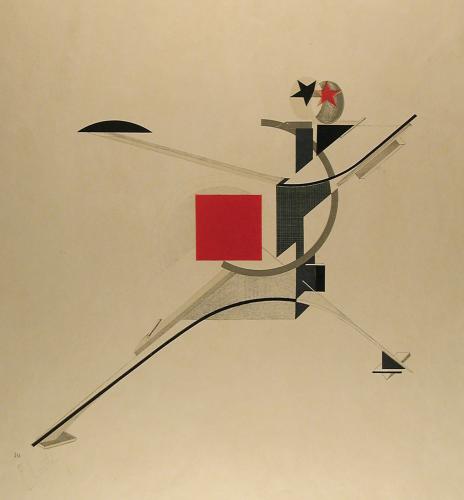Constructs for a Brave New World
dal 25/7/2003 al 16/11/2003
Segnalato da
Williams College Museum of Art
25/7/2003
Constructs for a Brave New World
Williams College Museum of Art, Williamstown
El Lissitzky's Proun and Victory Over the Sun Portfolios. El Lissitzky's Proun and Victory over the Sun Portfolios. The two portfolios, consisting of eighteen lithographs and two covers by the pioneering Russian avant-garde artist El Lissitzky, are drawn from the collection of A. Fenner Milton (Williams College Class of 1962). The installation, created by Chief Preparator Hideyo Okamura, is unique in that it responds directly to Lissitzky's innovative theories and practice of exhibition design.

El Lissitzky's Proun and Victory Over the Sun Portfolios
July 26-November 16, 2003 at the Williams College Museum of Art
Williamstown, MA-Williams College Museum of Art (WCMA) will present Constructs for a Brave New World: El Lissitzky's Proun and Victory over the Sun Portfolios. The two portfolios, consisting of eighteen lithographs and two covers by the pioneering Russian avant-garde artist El Lissitzky, are drawn from the collection of A. Fenner Milton (Williams College Class of 1962) and will be on view from July 26 through November 16, 2003. The installation, created by Chief Preparator Hideyo Okamura, is unique in that it responds directly to Lissitzky's innovative theories and practice of exhibition design.
'Williams College Museum of Art is honored to be exhibiting these two important portfolios by El Lissitzky,' says Director Linda Shearer. 'Lissitzky was a pioneer of modern art, notably Russian Constructivism, and these prints beautifully demonstrate the sense of optimism and experimentation that was so characteristic of his work, as well as that of his peers, like Kazimir Malevich and Vladimir Tatlin. I am also delighted that Williams alumnus Fenner Milton is so generously sharing this work with the Williams community for all our visitors to see.'
Lissitzky: An Artist for the Masses
Arriving at artistic maturity on the cusp of the 1917 Russian Revolution, Lazar 'El' Lissitzky (1890-1941) was dedicated to new Soviet goals, such as training artists to benefit the state and society rather than the individual. He was adamant about renouncing private and elite forms of art-making, such as oil painting, for work that was egalitarian, affordable, and comprehensible to the masses. Toward that end he turned to printed forms like posters, books, and prints that could be mechanically reproduced in considerable numbers. The two lithographic portfolios on view are consistent with that mission.
Proun and Victory over the Sun Portfolios
The Proun portfolio (Proun is Lissitzky's acronym for 'Project for the Establishment of a New Art') consists of six images of abstract geometric forms that were meant to function as prototypes for future mechanical and architectural designs. He considered them part of a new abstract language that would be universally understood by all people. The second portfolio recasts the human protagonists originated by Kazimir Malevich for the 1913 Futurist opera Victory over the Sun as electro/mechanical puppets. That opera tells the story of a time when man's technological innovations have made the sun obsolete, emphasizing the potential for immense societal change through technology. Lissitzky's robotic creations are fitting inhabitants of a sunless world. Although created solely from geometric shapes, the figures nonetheless have human expressions and forms in line with their function. Thus, for example, Globetrotter in Time is composed of an airplane propeller and wheels, while the Gravediggers are grim beings shaped life coffins. Though they were never realized in three-dimensional form, Lissitzky's lithographic portfolio of nine designs for the characters in Victory over the Sun is considered one of the most important graphic achievements of the twentieth century.
Daring Exhibition Designs
Trained as an engineer and architect, Lissitzky was one of the first modern artists to experiment with the viewer as an integral part of a work of art. For the Great Berlin Art Exhibition in 1923 Lissitzky translated his geometric Proun compositions into a room-size environment. He intended the wall-size abstractions to engulf visitors and allow them to feel as if they were floating in space. He was also an inventive exhibition designer who placed frames at irregular heights or kitty-corner on the wall, turned works upside down, and shunned traditional backdrops. Contemporary exhibitions of Lissitzky's work rarely consult his ideas on exhibition design. Hideyo Okamura's design for WCMA attempts to redress this lapse through an installation that captures the spirit of Lissitzky's writings and teachings on exhibition design. Lissitzky wrote of his 1923 Berlin Proun room, 'The image is not a painting, but a structure around which we must circle, looking at it from all sides, peering down from above, investigating from below.'
Constructs for a Brave New World has been organized by Deborah Rothschild, Senior Curator of Modern and Contemporary Art, with the assistance of Amelia Avdic and Patricia Hickson, Williams College Graduate Program in the History of Art.
Image: El Lissitzky (Russian, 1890-1941)
Neuer (New Man), 1923
lithograph
Collection of A. Fenner Milton '62
The Williams College Museum of Art is open Tuesday through Saturday, from 10 a.m. to 5 p.m., and Sunday, from 1 to 5 p.m. Admission is free and the museum is wheelchair accessible.
Contact: Jonathan Cannon, Public Relations Coordinator 413.597.3178;
Press Releases
Williams College Museum of Art 15 Lawrence Hall Drive, Ste 2
Williamstown, MA 01267
t: 413.597.2429 f: 413.458.9017



